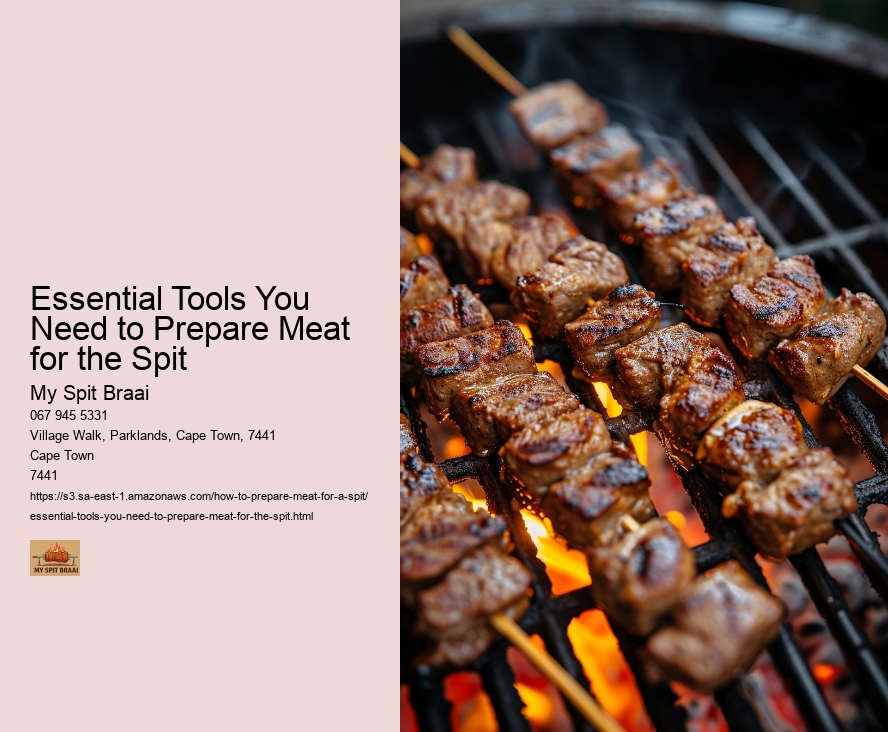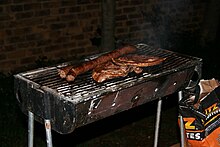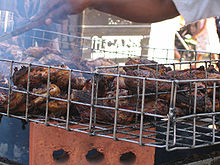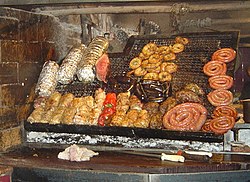Selecting the Right Spit: Size and Material Considerations
When preparing meat for roasting on a spit, selecting the right equipment is not only essential for ease of cooking but also impacts the flavor and texture of your final dish. The spit itself, being central to this method of cooking, requires careful consideration in terms of size and material.
Firstly, the size of the spit is crucial and should be chosen based on the type and quantity of meat you intend to cook. For large gatherings where whole pigs or lambs are roasted, a robust and longer spit is necessary to support the weight and ensure even cooking. Conversely, for smaller cuts such as chicken or kebabs, a shorter and thinner spit suffices. It's important to ensure that the length and strength of the spit can accommodate the weight without bending or warping during cooking.
Material choice is equally significant. Stainless steel spits are highly recommended due to their durability and resistance to rust. This is particularly important as the spit will be exposed to high heat for extended periods which can degrade lesser materials over time. Stainless steel also ensures easy cleaning, helping maintain hygiene each time you roast.
Aluminum spits are another option and are lighter than stainless steel, making them easier to handle, especially when loaded with heavy cuts of meat. However, they may not hold up as well under intense heat compared to their stainless steel counterparts.
Moreover, consider if you need a manual or motorized spit. Motorized options provide a consistent rotation speed which helps in cooking meat evenly without much manual effort – essential when dealing with larger meats like whole lambs or pigs that take several hours to cook thoroughly.
In conclusion, choosing the right spit involves considering both its size and material alongside what you plan on cooking. Opting for durable materials like stainless steel might be an initial investment but proves cost-effective in long-term utility and maintenance. Ensuring your spit has adequate length and strength will make all the difference in achieving deliciously roasted meats that are cooked evenly throughout. Such attention to detail will enhance your roasting experience, making it both enjoyable and successful every time.
Meat Thermometers: Ensuring Perfect Cooking Temperatures
When preparing meat for the spit, one of the most crucial tools you can have at your disposal is a reliable meat thermometer. This essential device ensures that your meats are cooked to perfection, hitting the right internal temperatures not only for optimal taste and texture but also for safety.
Cooking meat on a spit involves constant rotation over a heat source, which can make it challenging to gauge doneness purely by appearance or time. Different meats require specific internal temperatures to be considered safe and properly cooked. For instance, poultry should reach an internal temperature of 165°F (74°C) to ensure all harmful bacteria are destroyed, while beef might vary depending on the desired level of doneness, ranging from 125°F (52°C) for rare to 160°F (71°C) for well done.
A good meat thermometer takes the guesswork out of this process. By inserting the probe into the thickest part of the meat, away from bone or fat, you get an accurate reading of the internal temperature. This accuracy is crucial not only for safety but also for preserving the quality of the meat. Overcooking can lead to dryness and toughness, while undercooking can pose health risks.
There are several types of meat thermometers available in the market: dial thermometers, which provide a traditional approach with a needle readout; digital instant-read thermometers, offering quick and highly accurate readings; and smart thermometers that can connect to a mobile app to monitor the temperature remotely-particularly useful when cooking large cuts on a spit where constant manual checking can be cumbersome.
Using these tools effectively means more than just achieving safe cooking temperatures; it's about respecting the ingredients and maximizing their culinary potential. A perfectly cooked piece of meat is juicy, flavorful, and tender; qualities that can elevate any meal from ordinary to extraordinary. Moreover, understanding how different factors-such as type of meat, its size and shape, and how heat interacts with these elements-affect cooking allows you even greater control over your grilling or roasting outcomes.
In conclusion, investing in a good quality meat thermometer is indispensable when preparing meat on a spit. It ensures food safety and elevates your culinary skills by helping you serve deliciously cooked meals every time. Whether you're an experienced chef or just starting out with spit-roasting at home gatherings or camping trips-it's one tool that promises confidence right up to every last bite.
Marinades and Rubs: Flavor Enhancements for Spit Cooking
In the art of spit cooking, where meat is roasted over an open flame or heat source, achieving deep, rich flavors is paramount. Two essential techniques that play a crucial role in enhancing these flavors are the use of marinades and rubs. Both methods not only elevate the taste but also improve the texture and overall appeal of the meat, making them indispensable tools for any aspiring spit-roast chef.
Marinades are liquid solutions that meat is soaked in before cooking. Typically composed of acids like vinegar or citrus juice, oils, herbs, and spices, marinades serve multiple purposes. The acidic components help in tenderizing the meat by breaking down tough fibers, making it more tender and juicy when cooked. The oil helps to keep the moisture intact during the high heat of spit roasting. Herbs and spices infuse distinctive flavors that penetrate deeply as the meat slowly turns and cooks. A well-marinated piece of meat can transform a simple roast into a succulent feast, dripping with layers of flavor.
On the other hand, rubs are mixtures of dry spices and herbs that are massaged directly onto the surface of the meat before it is cooked. They create a crust-like surface that not only imparts intense flavors but also helps to seal in juices, ensuring that the meat remains moist and flavorful throughout the cooking process. Rubs can vary from simple salt and pepper combinations to complex blends involving exotic spices like cumin or smoked paprika, depending on personal preference and culinary traditions.
When preparing meat for spit cooking using these methods, certain tools enhance their effectiveness. For marinades, a large glass or ceramic dish works best as it won't react with acidic ingredients. Alternatively, resealable plastic bags can be used for easier cleanup and more efficient space usage in your refrigerator while marinating overnight. Having a set of mixing bowls and whisks on hand allows for easy preparation of homemade marinade recipes tailored to specific tastes.
For applying rubs efficiently, small bowls are essential for mixing your spices just before coating your meats; this keeps all ingredients fresh and potent. A spice grinder might be necessary if you prefer using whole spices for their freshness-they can be ground when needed to maximize flavor impact.
Additionally, brushes or spoons may be used to ensure even application of both wet marinades and dry rubs over irregularly shaped cuts intended for spit roasting.
In conclusion, mastering the use of marinades and rubs is vital for anyone looking to excel at spit cooking. These flavor enhancements do more than just season; they transform basic cuts into culinary delights that tantalize taste buds with every turn over flames or coals-making them truly essential tools in any pitmaster's arsenal.
Carving Sets: Essential for Serving Spit-Roasted Meats
When it comes to the art of preparing and serving spit-roasted meats, having the right tools at your disposal can transform the entire experience from good to exceptional. Among these essential tools, carving sets hold a place of particular importance. Designed specifically for slicing through cooked meat with precision and ease, a good carving set not only enhances the presentation but also respects the texture and flavor of the meat.
Spit-roasting itself is an age-old cooking method where meat is skewered on a long rod and roasted over a heat source. This method allows for even cooking and imparts a distinct flavor that is hard to replicate with other cooking techniques. The meats often used range from whole chickens and turkeys to large cuts of beef or lamb. Given this variety, the challenge lies in serving these beautifully roasted delights in a manner that is both efficient and elegant.
This is where carving sets come into play. Typically comprising a carving knife and a fork, these sets are specially designed to handle large cuts of meat. The carving knife usually features a long, thin blade that ensures precise cuts, allowing you to slice through the crispy outer layer without shredding the tender meat inside. The fork aids in this process by holding the meat steady as you carve.
Choosing the right carving set can be crucial. Look for knives with high-quality stainless steel blades that offer durability and longevity. Ergonomic handles are also essential as they provide comfort and control during the carving process, which can be especially helpful when dealing with larger pieces of meat or entertaining a sizable group.
Moreover, mastering the use of these tools requires practice and technique. It's advisable to learn proper carving methods such as slicing against the grain of the meat to ensure each piece is as tender as possible. Serving spit-roasted meats isn't just about cutting; it's about crafting an experience for your guests.
In conclusion, while many tools are important in preparing meat for spit-roasting-such as skewers for securing the meat or basting brushes for applying marinades-a quality carving set truly becomes central when it's time to serve. It not only makes the process smoother but also elevates your role from merely someone behind-the-scenes at a barbecue to an artisan presenting their craft at its best.






























